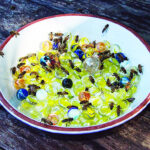DIY Wildlife Habitats
by Ana Morlier
Happy April, readers! A lovely month of spring flowers, planting, and, hopefully, more time outside. With all of these advantages, it’s time to give back to the Earth during the renewal of spring, to do your due diligence on Earth Day.
Let’s make strides to undo the urban human destruction that destroys local habitats. Let’s create a safe haven for all animals. Here are a few tips and tricks to make your yard more wildlife-friendly! And, remember, any new plants you use should be native to Maryland.
Natural Food Options for Animals (small wildlife)
Nectar (hummingbird feeder, native flowers).
Pollen (native flowers, butterfly weed, ironweed, false blue indigo, etc.).
Foliage such as ferns (groundcover, lady, Christmas), wool rush/grass, black chokeberry, fothergilla, oakleaf hydrangea, and sweet pepperbush.
Old or rotting trees (which can provide lichen, moss, and fungi for all sorts of animals and insects).
Bugs are actually quite important for birds, acting as an important food source. For example, hummingbirds love nectar, but also graze on mosquitoes, gnats, and even spiders for protein.
Add food sources. If you’re okay with having larger animals in your yard, add food sources such as berries, nuts, and seeds. These might include black-eyed susans, black chokeberry, lowbush blueberry, inkberry holly, winterberry holly, and red chokeberry. In addition, acorns, pinecones (for birds), and seedy flowers.
Animal Upkeep
A birdbath. It doesn’t have to be anything fancy! It can be a flowerpot, formal birdbath, or even an old cake pan (that has depth). Make sure you have a plate or pan to catch water under the bath.
A water source for bees and butterflies. Something as simple as filling a bowl (plastic, ceramic, etc.) with pebbles and a small amount of water so they can perch on the pebbles to drink. Honey bees especially love salt water. Bees in general will be more attracted to the source if it has an earthy scent like moss, wet earth, salt, and even sugar. They are also attracted to the scent of chlorine, thus why you’ll see so many floating bees in the pool. You can use chlorine beside the water source to attract more bees, if desired. After the bees get used to the location you’ve set the watering station you won’t have to keep adding extra scent. Coming to the watering station will become a habit for bees.
Make a toad abode. All you’ll need is a small entrance in a flower or terra-cotta pot (flipped upside down for cover) for the toad to get into. Even a carved-out tree stump works. Make sure there is some gravel, mulch, or plant life around the abode.
Once again, provide shelter. Tall grasses (wool grass, little bluestem, yellow Indian grass), shrubs (listed above), and trees (can be dead) are best for shelter and hiding.
Other Tips
Allow weeds to grow, as it also offers groundcover.
Resist the urge to use insecticide! If you absolutely need to, make sure the insecticide is a natural substance, such as neem oil, vegetable oil, or vinegar.
Hold off on deadheading if the flower stalk has lots of seeds. Wait until birds or other critters have taken as much as they need, then deadhead.
If you have pets, try attracting pollinators with flowers only for a safer environment (without the risk of encountering other animals).
Always try to plant perennials if you can for year-round sustainability.
If you have the time, plan out the bloom time of plants so you have flowers, berries or nuts at various times of the year.
May this be a helpful guide to starting out making a natural habitat.
The best resource for the layout and plants in your garden is the National Wildlife Federation. The website has a plethora of resources and information for any setting, such as school, work, and animal-specific habitats.
Thank you for giving back to the Earth during the renewal of spring, and best of luck!
Photo Courtesy of Rusty Burlew of Backyard Beekeeping
Credit to: University of Maryland Extension, Rusty Burlew of Backyard Beekeeping, Monica Russo of Audubon, and the National Wildlife Federation.


